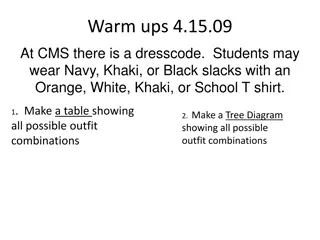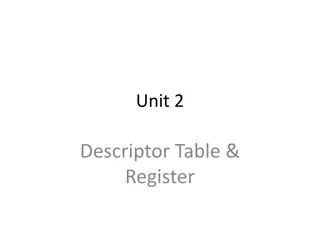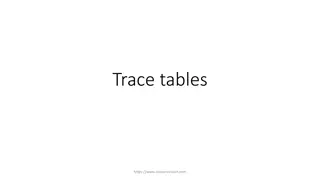Life Tables
Life tables are statistical tools that show the probability of individuals dying before their next birthday at different ages. They include key metrics like life expectancy, survival probabilities, and average number alive between age intervals. Learn how to interpret and calculate values in a life table, and discover their importance across various fields such as demography and biology.
Download Presentation

Please find below an Image/Link to download the presentation.
The content on the website is provided AS IS for your information and personal use only. It may not be sold, licensed, or shared on other websites without obtaining consent from the author.If you encounter any issues during the download, it is possible that the publisher has removed the file from their server.
You are allowed to download the files provided on this website for personal or commercial use, subject to the condition that they are used lawfully. All files are the property of their respective owners.
The content on the website is provided AS IS for your information and personal use only. It may not be sold, licensed, or shared on other websites without obtaining consent from the author.
E N D
Presentation Transcript
Outline: What is a life table What does a life table look like Calculations in a life table Life expectancy
A life table is a table which shows, for a person at each age, what the probability is that they die before their next birthday A number of statistics can be derived and be included in the table as: The probability of surviving any particular year of age.
The remaining life expectancy for people at different ages The proportion of the original birth cohort still alive Life tables are also used in biology
Average number alive between age interval
First four columns of the life table: Life table variables : 1. Age interval (e.g. 1year, 1-4 years, etc.) 2. ( nq ) the percent of dying between ages x and age x+n 3. ( l ) Number of alive at an exact age x n d Number of deaths between ages x and x+n 4.
How to calculate nd: How to calculate number of deaths nd between exact ages x to x+n This is column 4 We multiply column 2 by column 3 to obtain column 4, that is:
( column 4) = nq (Column 2) x l (Column 3) This is multiplying: (l ), number alive at the start of age interval by The proportion of dying in that interval (nq )
Example: How to calculate nd Ages X to X + n 5-9 Column 2 nq .00877 Column 3 I 92734 Column 4 nd 813 Column 5 nL 461637 q I d .00877 x 92,734 = 813
Example: nd = (I ) x (nq ) nd =( l ) x ( q ) I = 92,734 q = .00877 d = .00877 x 92,734 = 813
The number dying in an age interval can also be expressed as the difference between two adjacent l values. That is: nd = l - l d = l - l
Ages X to X + n 5-9 10- 14 Column 2 nq .00877 .00604 Column 3 l 92734 91921 Column 4 nd 813 555 Column 5 nL 461637 458217 l = 92,734 l = 91, 921 d = l - l = 92,734 - 91, 921 = 813
Ages X to X + n 15-19 20-24 Column 2 nq .01306 .03161 Column 3 l 91366 90173 Column 4 nd 1193 2851 Column 5 nL 453847 443736 I = 91366 I = 90173 d = I - I = 91366 - 90173 = 1193
5. nL Average number alive between exact ages x to x + n Can be calculated as the: Average of the l values at the start (l ) and end of the interval (l n) nL = ? 2(l + l )
Ages X to X + n 10-14 15-19 20-24 Column 2 nq 0.00604 .01306 .03161 Column 3 I 91921 91366 90173 Column 4 nd 555 1193 2851 Column 5 nL 458217 453847 443736 l = 90173 l = 91366 L = 5 2(I + I )
Substitute: I = 91366 and I = 90173 We get: L = 5 2 (91366+ 90173) = 453847
Total population aged x and over (T) Obtained from the nL values. Defined as the total population aged x years and over.
T= L + L + L + .. T = L + L + L + . T = 381393 + 334799 + 275667 + 204369 + 206269 = 1402497
What is L? We noted that of those who die aged 0, the average age at death is usually much less than 6 months. A better approximation to reality, but still simple, for the first year of life is: L = .3l + .7I i.e. L = I + .3 ( I - I ) Note that this counts 0.3 of a year for each child that dies aged 0.
What is life expectancy? Life expectancy at birth in KSA is now 76.3 years. This means that a baby born now will live 76.3 years if the baby experiences the same age- specific mortality rates as are currently operating in KSA
How to calculate life expectancy ( e) The life table function e refers to life expectancy from an exact age x. For example, e is the life expectancy at exact age 30, or the average number of years lived from the 30th birthday
Equation for e= Total person-years of life lived after exact age x ( T ) Divided by the total persons alive at the exact age x ( l ) This represents the number if years lived by people aged x: e = T / L
Ages X to X + n Column 2 I 90547 86208 79646 Column 3 T Column 4 e 21.97 17.95 14.23 60-64 65-69 70-74 1989624 1547738 1133102 I = 86208 T = 1547738 e = 1547738 / 86208 = 17.95
Example1: Find e the life expectancy at the exact age 65: e = T / I e = 1547738 / 86208 = 17.95
Ages X to X + n Column 2 I 90547 86208 79646 Column 3 T Column 4 e 21.97 17.95 14.23 60-64 65-69 70-74 1989624 1547738 1133102 I = 79646 T =1133102 e = 1133102 / 79646 = 14.23
Example: Find e the life expectancy at the exact age 70: e = T / I e = 1133102 / 79646 = 14.23























